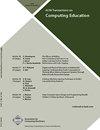You’re Hired! A Phenomenographic Study of Undergraduate Students’ Pathways to Job Attainment in Computing
IF 3.2
3区 工程技术
Q1 EDUCATION, SCIENTIFIC DISCIPLINES
引用次数: 0
Abstract
Although there is a great demand for graduates in computing fields, companies frequently struggle to find enough workers. They may also grapple with obtaining racial, ethnic, and gender diversity in representation. It has been suggested that the hiring process further contributes to these inequities. This study examined undergraduate computing students’ experiences with technical interviews and their pathways to job attainment, focusing on men and women who identify as Black or African American, Hispanic or Latinx, Asian, and mixed-race. We applied the community cultural wealth framework and employed the methodology of phenomenography to investigate the different assets that students leveraged to succeed in obtaining a position. Our investigation centered around the conceptions of sixteen computing students, all of whom completed at least one technical interview and received at least one job offer. We conducted semi-structured interviews to explore their interpretations of the hiring process, the resources they utilized, and their perceptions of inclusivity in the field. The findings illustrated that students’ support mechanisms included the following categories of description: intrinsic characteristics, capitalizing on experience, community, preparation, and organizational. They relied heavily on distinct forms of capital, particularly social and navigational, to attain a job in computing. Peers and clubs or groups were essential for students to learn about what to expect during the hiring process, to help them prepare, and to make connections with employers. They also helped the students cope with the discrimination they faced throughout their professional trajectories. By investigating the various experiences students have, we contribute to the understanding of how hiring practices may be viewed as well as possible ways to provide support. While students must study for technical interviews and refine their skills and pertinacity in the face of obstacles, industry and academia should consider their role in hiring and its impact. Transparency in what to expect and enhanced preparation opportunities could serve to make the process more equitable for all job candidates.你被录用了计算机专业本科生就业途径的现象学研究
虽然计算机领域对毕业生的需求量很大,但公司往往很难找到足够的员工。他们可能还在为获得种族、民族和性别多样性的代表性而苦恼。有人认为,招聘过程进一步加剧了这些不平等现象。本研究考察了计算机专业本科生参加技术面试的经历及其获得工作的途径,重点关注被认定为黑人或非裔美国人、西班牙裔或拉丁裔美国人、亚裔以及混血儿的男性和女性。我们应用了社区文化财富框架,并采用现象学的方法来调查学生在成功获得职位时所利用的不同资产。我们的调查围绕 16 名计算机专业学生的观念展开,他们都完成了至少一次技术面试,并收到了至少一份工作邀请。我们进行了半结构式访谈,以探讨他们对招聘过程的理解、他们所利用的资源以及他们对该领域包容性的看法。研究结果表明,学生的支持机制包括以下几类描述:内在特征、利用经验、社区、准备和组织。他们在很大程度上依赖于不同形式的资本,尤其是社会资本和导航资本,以获得计算机领域的工作。同学和俱乐部或团体对于学生了解招聘过程中的预期、帮助他们做好准备以及与雇主建立联系至关重要。他们还帮助学生应对在整个职业生涯中所面临的歧视。通过调查学生的各种经历,我们对如何看待招聘行为以及提供支持的可能方式有了更深入的了解。学生们必须为技术面试进行学习,并在面对障碍时锤炼自己的技能和坚持不懈的精神,同时,业界和学术界也应考虑他们在招聘中的角色及其影响。提高期望值的透明度和增加准备机会,可以使这一过程对所有求职者更加公平。
本文章由计算机程序翻译,如有差异,请以英文原文为准。
求助全文
约1分钟内获得全文
求助全文
来源期刊

ACM Transactions on Computing Education
EDUCATION, SCIENTIFIC DISCIPLINES-
CiteScore
6.50
自引率
16.70%
发文量
66
期刊介绍:
ACM Transactions on Computing Education (TOCE) (formerly named JERIC, Journal on Educational Resources in Computing) covers diverse aspects of computing education: traditional computer science, computer engineering, information technology, and informatics; emerging aspects of computing; and applications of computing to other disciplines. The common characteristics shared by these papers are a scholarly approach to teaching and learning, a broad appeal to educational practitioners, and a clear connection to student learning.
 求助内容:
求助内容: 应助结果提醒方式:
应助结果提醒方式:


